California Academy of Sciences: Rainforests of the World
California Academy of Sciences: Rainforests of the World
For D.'s recent birthday we spent a special day in San Francisco at the California Academy of Sciences in Golden Gate Park, noted for its recent make-over, including the living, 4-story Rainforests of the World exhibit. Here are some of the pics I took.
While waiting to enter the exhibit, we see a blue morpho clinging to the inside of the 90' tall rainforest dome.

Rainforest plants look familiar because a lot of our common houseplants are native to that kind of environment. (Shown: prayer plant, philodendron, parlor palm.)

The ground floor of the rainforest. There are several hundred species of plants in the exhibit, including a cacao tree that is hand-pollinated every week by a museum volunteer to bear fruit.

The Kuhl's flying gecko (Ptychozoon kuhli) can glide from tree to tree or even down to the ground.

This one might be renamed Kuhl's clinging gecko.

The file-eared tree frog (Polypedates otilophus) is mostly arboreal and is usually found on vegetation near pools of standing water.

The flying snake (Chrysopelea paradisi) can glide from tree to tree by flattening its body and launching itself into the air from a high branch.


A longwing butterfly in a primeval scene, silhouetted by one of the roof skylights.

One of the beautiful macaws in the rainforest.

"So, Mr. Bond, we meet again."
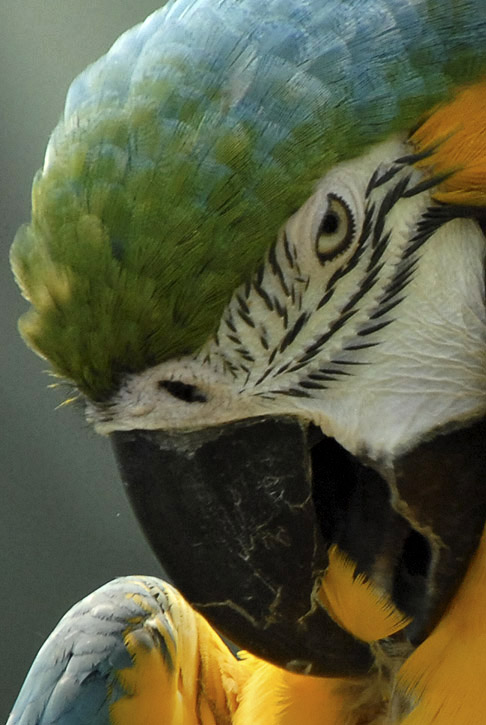
Another blue morpho.


This level of the rainforest represents a Madagascar understory.

Temperatures are kept between 82 and 85°F, and humidity is kept at 75% or higher using a special misting system.
Looking up past the backdrop that screens the elevator to the skylighted roof, which supplements the metal halide lighting replicating tropical sunlight.


Looking down into the Amazonian flooded forest section.

For mental stimulation, the macaws are given enrichment several times a day to keep their minds engaged, including fruit kebabs and things to tear up with their beaks.

The blue and gold macaw has stunning plumage.

One of the rainforest gecko species.

The giant day gecko is about a foot long.



Some orb weaver (Nephila sp.) spiders.


Another look up at the skylighted roof.

Sapho longwing butterfly (Heliconius sapho) on rubber tree (another houseplant native to the rainforest).

Here is the postman butterfly (Heliconius melpomene), whose larvae feed on passionflowers.
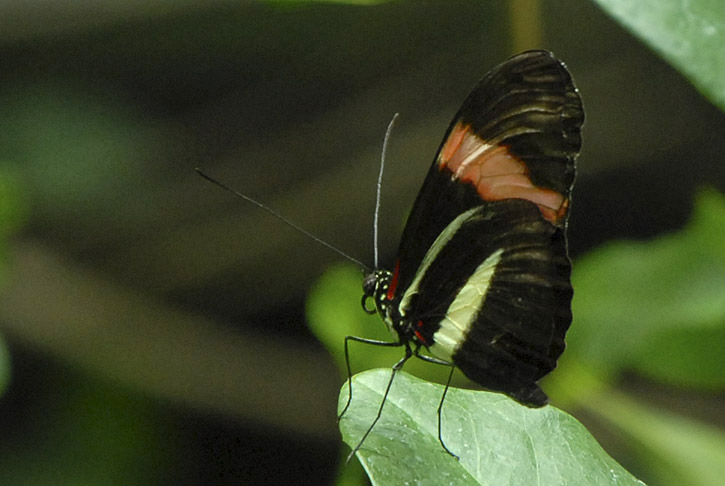
Like the blue morpho, the banded orange heliconian (Dryadula phaetusa) is another butterfly with a different pattern on its underside.


In addition to flower nectar, these adult butterflies will also feed on bird droppings.
Butterfly feeding station offering nectar, and a zebra longwing (Heliconius charitonius) feeding.


Begonia on one of several living walls in the exhibit.


A lot of these plants would grow as epiphytes on a tree trunk or limb in crevices that collect just enough soil and decomposing organic material to support a small root system.
The reflective silvery surface of much of the golden silk orb weaver (Nephila clavipes) is thought to prevent overheating in the hot tropical sun.

Its gold-colored dragline silk has amazing tensile strength.
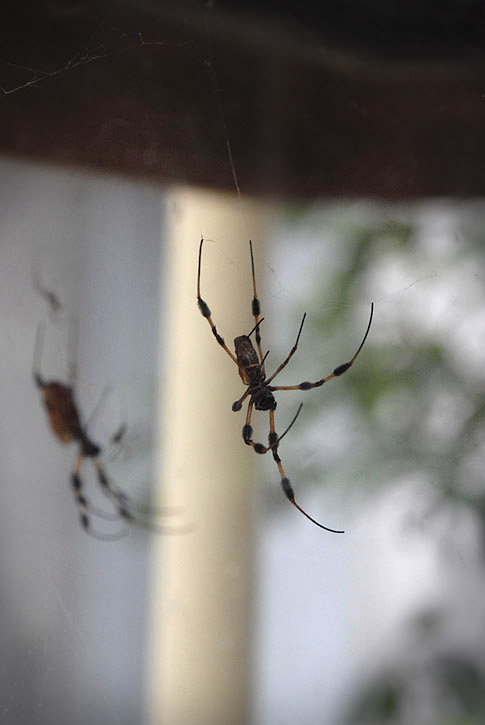
Golden silk orb weavers are known to occasionally eat prey as big as small birds, but mostly eat flying insects.
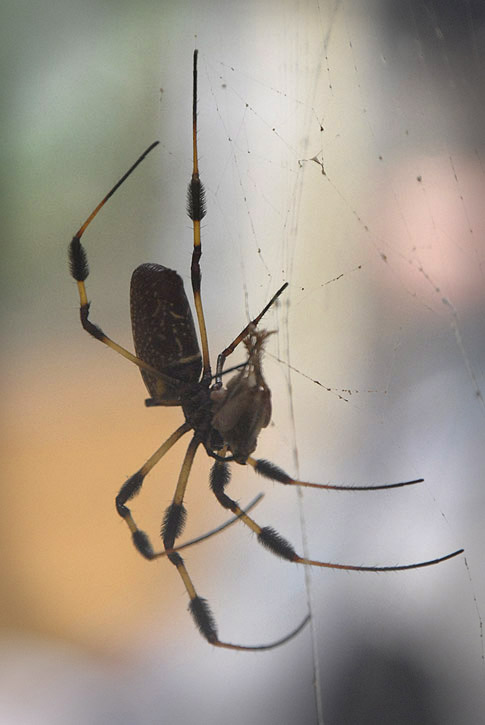
The females can get up to 2 inches long, not counting the legs. Males are a lot smaller.

These spiders are not considered dangerously venomous to humans.

The green and black poison dart frog (Dendrobates auratus) almost looks like a toy, but it would be a serious mistake to pick one up and play with it.

A stunning blue morpho.

Most of the butterfly species in this exhibit live approximately 1-2 weeks as adults, just long enough in the wild to reproduce (which they don't in this museum, as their hungry caterpillars would chew down the entire rainforest exhibit).
The tiger tree snake (Spilotes pullatus) lives in the Costa Rican rainforest canopy.

One of the fish that lives in the Amazonian flooded forest. This one looks like an angelfish.

Looking up into the 100,000-gallon flooded forest tank from a tunnel below it, we get some weird views of giant catfish.


Here is a normal-looking (but still really big) redtail catfish.


Here is the peculiar-looking armored catfish.
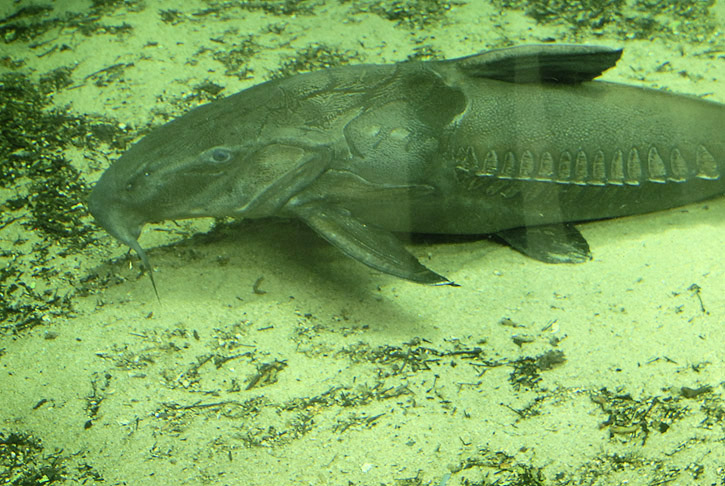
Fish's-eye view: looking up from below the flooded forest through the rainforest exhibit to the metal halide lights and the skylights in the roof.
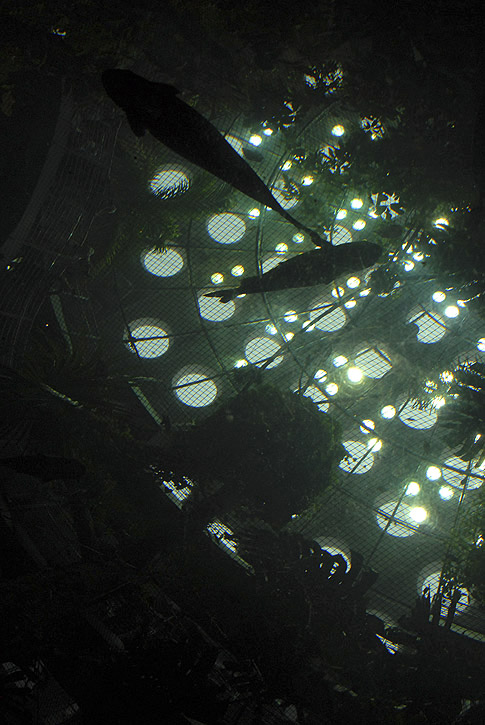
More pics:
Snakes and Lizards here.
Coral Reef here.
African Hall here.
California Coast here.
Miscellaneous here.
.
.
For D.'s recent birthday we spent a special day in San Francisco at the California Academy of Sciences in Golden Gate Park, noted for its recent make-over, including the living, 4-story Rainforests of the World exhibit. Here are some of the pics I took.
While waiting to enter the exhibit, we see a blue morpho clinging to the inside of the 90' tall rainforest dome.

Rainforest plants look familiar because a lot of our common houseplants are native to that kind of environment. (Shown: prayer plant, philodendron, parlor palm.)

The ground floor of the rainforest. There are several hundred species of plants in the exhibit, including a cacao tree that is hand-pollinated every week by a museum volunteer to bear fruit.

The Kuhl's flying gecko (Ptychozoon kuhli) can glide from tree to tree or even down to the ground.

This one might be renamed Kuhl's clinging gecko.

The file-eared tree frog (Polypedates otilophus) is mostly arboreal and is usually found on vegetation near pools of standing water.

The flying snake (Chrysopelea paradisi) can glide from tree to tree by flattening its body and launching itself into the air from a high branch.


A longwing butterfly in a primeval scene, silhouetted by one of the roof skylights.

One of the beautiful macaws in the rainforest.

"So, Mr. Bond, we meet again."

Another blue morpho.


This level of the rainforest represents a Madagascar understory.

Temperatures are kept between 82 and 85°F, and humidity is kept at 75% or higher using a special misting system.
Looking up past the backdrop that screens the elevator to the skylighted roof, which supplements the metal halide lighting replicating tropical sunlight.


Looking down into the Amazonian flooded forest section.

For mental stimulation, the macaws are given enrichment several times a day to keep their minds engaged, including fruit kebabs and things to tear up with their beaks.

The blue and gold macaw has stunning plumage.

One of the rainforest gecko species.

The giant day gecko is about a foot long.



Some orb weaver (Nephila sp.) spiders.


Another look up at the skylighted roof.

Sapho longwing butterfly (Heliconius sapho) on rubber tree (another houseplant native to the rainforest).

Here is the postman butterfly (Heliconius melpomene), whose larvae feed on passionflowers.

Like the blue morpho, the banded orange heliconian (Dryadula phaetusa) is another butterfly with a different pattern on its underside.
In addition to flower nectar, these adult butterflies will also feed on bird droppings.
Butterfly feeding station offering nectar, and a zebra longwing (Heliconius charitonius) feeding.


Begonia on one of several living walls in the exhibit.


A lot of these plants would grow as epiphytes on a tree trunk or limb in crevices that collect just enough soil and decomposing organic material to support a small root system.
The reflective silvery surface of much of the golden silk orb weaver (Nephila clavipes) is thought to prevent overheating in the hot tropical sun.

Its gold-colored dragline silk has amazing tensile strength.

Golden silk orb weavers are known to occasionally eat prey as big as small birds, but mostly eat flying insects.

The females can get up to 2 inches long, not counting the legs. Males are a lot smaller.

These spiders are not considered dangerously venomous to humans.

The green and black poison dart frog (Dendrobates auratus) almost looks like a toy, but it would be a serious mistake to pick one up and play with it.

A stunning blue morpho.

Most of the butterfly species in this exhibit live approximately 1-2 weeks as adults, just long enough in the wild to reproduce (which they don't in this museum, as their hungry caterpillars would chew down the entire rainforest exhibit).
The tiger tree snake (Spilotes pullatus) lives in the Costa Rican rainforest canopy.

One of the fish that lives in the Amazonian flooded forest. This one looks like an angelfish.

Looking up into the 100,000-gallon flooded forest tank from a tunnel below it, we get some weird views of giant catfish.


Here is a normal-looking (but still really big) redtail catfish.


Here is the peculiar-looking armored catfish.

Fish's-eye view: looking up from below the flooded forest through the rainforest exhibit to the metal halide lights and the skylights in the roof.

More pics:
Snakes and Lizards here.
Coral Reef here.
African Hall here.
California Coast here.
Miscellaneous here.
.
.